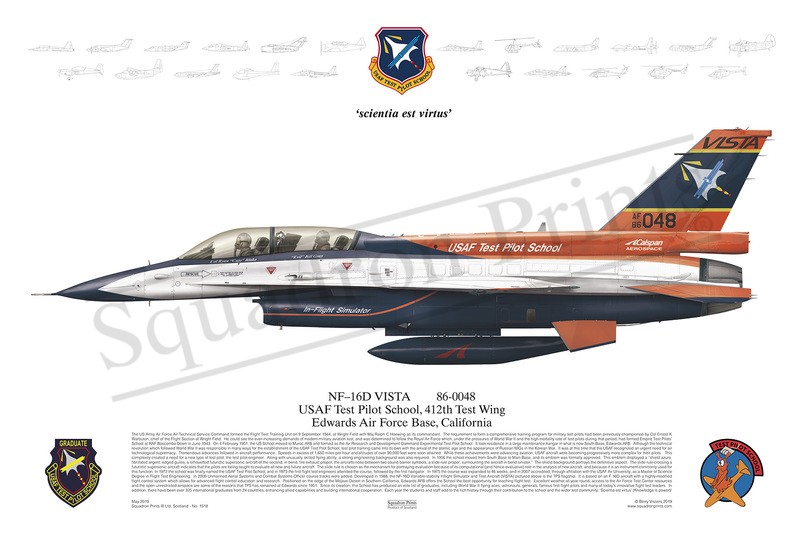#1518 NF-16D VISTA

Purchased products will not feature the Squadron Prints watermark
Description
Squadron Prints Lithograph No. 1518 - 86-0048, NF-16D VISTA, USAF Test Pilot School, 412th Test Wing, Edwards Air Force base, California.
The US Army Air Force Air Technical Service Command formed the Flight Test Training Unit on 9 September 1944, at Wright Field with Maj Ralph C Hoewing as its commandant. The requirement to form a comprehensive training program for military test pilots had been previously championed by Col Ernest K Warbuton, chief of the Flight Section at Wright Field. He could see the ever-increasing demands of modern military aviation test, and was determined to follow the Royal Air Force which, under the pressures of World War II and the high mortality rate of test pilots during that period, had formed Empire Test Pilots’ School at RAF Boscombe Down in June 1943. On 4 February 1951, the US School moved to Muroc AFB and formed as the Air Research and Development Command Experimental Test Pilot School. It took residence in a large maintenance hangar in what is now South Base, Edwards AFB. Although the technical revolution which followed World War II was responsible in many ways for the establishment of the USAF Test Pilot School, test pilot training came into its own with the arrival of the atomic age and the appearance of Russian MiGs in the Korean War. It was at this time that the USAF recognized an urgent need for air technological supremacy. Tremendous advances followed in aircraft performance. Speeds in excess of 1,650 miles per hour and altitudes of over 90,000 feet were soon attained. While these achievements were advancing aviation, USAF aircraft were becoming progressively more complex for their pilots. This complexity created a need for a new type of test pilot: the test pilot-engineer. Along with unusually skilled flying ability, a strong engineering background was also required. In 1956 the school moved from South Base to Main Base, and its emblem was formally approved. This emblem displayed a “shield azure, fibrillated argent, edged guiles, a silhouetted futuristic supersonic aircraft of the second, in bend, fire exhaust proper; the aircrafts nose between two sound barrier symbols, a slide rule proper, surmounting the aircraft in bend sinister.†The shield background portrays the defensive aspect. The slide rule crossing a futuristic supersonic aircraft indicates that the pilots are being taught to evaluate all new and future aircraft. The slide rule is chosen as the mechanism for portraying evaluation because of its computational (and hence evaluative) role in the analysis of new aircraft, and because it is an instrument commonly used for this function. In 1972 the school was finally named the USAF Test Pilot School, and in 1973 the first flight test engineers attended the course, followed by the first navigator. In 1975 the course was expanded to 46 weeks, and in 2007 accredited, through affiliation with the USAF Air University, as a Master of Science Degree in Flight Test Engineering. In 2009 Unmanned Aerial Systems and Combat Systems Officer course tracks were added. Developed in 1988, the NF-16D Variable-stability Inflight Simulator and Test Aircraft (VISTA) pictured above is the TPS flagship. It is based on an F 16D aircraft with a highly-modified flight control system which allows for advanced flight control education and research. Positioned on the edge of the Mojave Desert in Southern California, Edwards AFB offers the School the best opportunity for teaching flight test. Excellent weather all year round, access to the Air Force Test Center resources and the open unrestricted airspace are some of the reasons that TPS has remained at Edwards since 1951. Since its creation, the School has produced an elite list of graduates, including World War II flying aces, astronauts, generals, famous first flight pilots and many of today’s innovative flight test leaders. In addition, there have been over 325 international graduates from 24 countries, enhancing allied capabilities and building international cooperation. Each year the students and staff add to the rich history through their contribution to the school and the wider test community. 'Scientia est virtus' (Knowledge is power)!
You may also like
-
111 Squadron Triple Print Lightning Phantom F3
XV582 'M'; XR713 'C'; ZE734 'JU'RAF Leuchars -
Lynx
variousWestland Lynx of the Fleet Air Arm and Army Air CorpsRNAS Yeovilton; Dishforth; Middle Wallop; RNAS Portland
